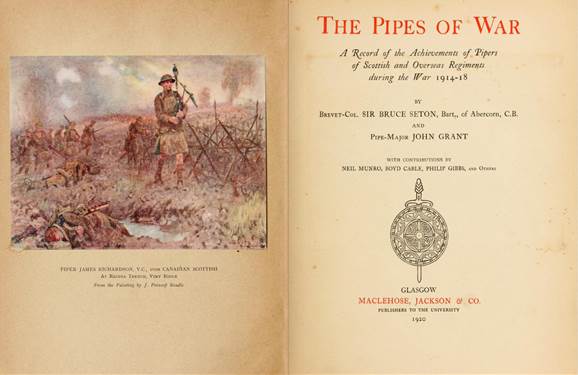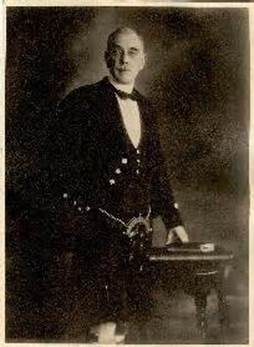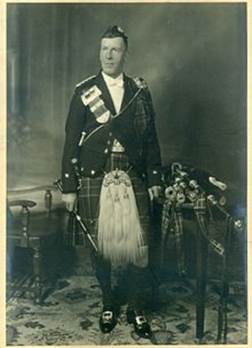| This Week’s Topic… | |||||||||

Best viewed in
|
The Pipes of War
Knowing how important a role religion played in the lives of the Indian patients at his hospital, Colonel Seton had a Gurdwara set up for the Sikhs and ensured that they were provided with the Guru Granth Sahibs. Colonel Seton also requested the Imam of the Woking mosque to visit the Kitchener hospital to discuss setting up a mosque for the Muslim patients. When the honor of Indian soldiers fighting on the frontlines in France was questioned by the military authorities suspecting that the cases of self-inflicted wounds were more common among Indian soldiers. It was Colonel Seton who on his own initiative undertook a top-secret medical study based on 1,000 wounded Indian soldiers admitted to the Kitchener hospital. Colonel Seton chose wounds for study which were most likely to be self-inflicted: wounds to the hand, of the arm and forearm, and wounds of the leg and foot. Colonel Setons findings indicated that the incidences of such wounds were by mere chance and statistics showed that the occurrences of such wounds among the Indian soldiers were no higher than among soldiers of other British regiments in the war.
Perhaps as a requirement for his employment as a legal clerk, Grant became skilled in calligraphy. His bagpipe teacher, Ronald MacKenzie, had impressed upon Grant early on in his tutelage the importance of copying and preserving ancient piobaireachd and Grant, as early as 1900, began compiling manuscripts of the "classical music of the bagpipe," for disseminating among those who were interested in them. Several such collections made their ways into the hands of members of the Highland Society of London and the newly-formed Piobaireachd Society. Because of the praise these organizations lavished on Grant for his exquisite workmanship, he decided to try his own hand at piobaireachd composition. Combining his talent for calligraphy with his knowledge of piobaireachd, on 20 July 1906 he composed "His Most Excellent Majesty King Edward VII's Salute," then prepared it as a beautifully-illuminated presentation folio to lay before the King. Edward VII graciously accepted the tune dedicated to him, thereby, in essence, granting John Grant license to do the same for others among the Royal Family, the nobility, and those of renown whom he deemed worthy of such an honor. By September 1907 Grant had composed, prepared in illuminated manuscript, and sent for acceptance, five more "royal" piobaireachds, all of which were gratefully accepted, either by those to whom they were dedicated, or a representative. In May 1908, in order to make them available to the public, he published—at his own expense--The Royal Collection of Piobaireachd: Besides the "Salute" written in honor of King Edward VII, the work included "His Royal Highness The Duke of Connaught's Salute" (i.e., Prince Arthur, Duke of Connaught and Strathearn) "Lament For Her Most Excellent Majesty Queen Victoria,", "His Grace The Duke of Fife's Salute," "Lord Archibald Campbell's Salute," and "The Piobaireachd Society's Salute." The work had over 160 subscribers, including those to whom the tunes were dedicated, other royals, and individuals from all walks of life, including such personages as Baron Strathcona and Mount Royal. Following successful publications of both editions of The Royal Collection of Piobaireachd, Grant decided to tackle the genre in a more comprehensive manner. The result was a 183-page volume entitled Piobaireachd: Its Origin and Construction; published at the author's expense by Aird & Coghill, Limited, Glasgow sometime in August, 1915. Known also by its Gaelic title Tus is Alt à Chiuil-Mhoir, Piobaireachd: Its Origin and Construction (hereafter POC) had an impressive list of patrons and subscribers, including Their Majesties King George V and Queen Mary of Teck, Her Majesty Queen Alexandra of Denmark, His Royal Highness the Prince of Wales Edward VIII, various other Royals, Nobles, and members of High Society, and—by no means least—The Highland Society of London. Despite Grant's tendency to be overly Romantic in his prose, the book remains a classic. The first of its kind, it still remains the largest compendium of articles on topics relating to the "National" music of Scotland in bagpipe literature. |
||||||||



